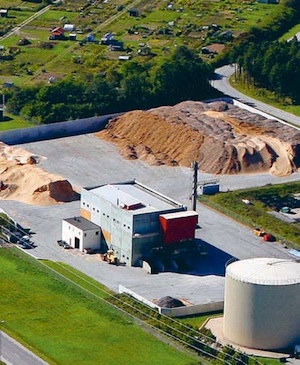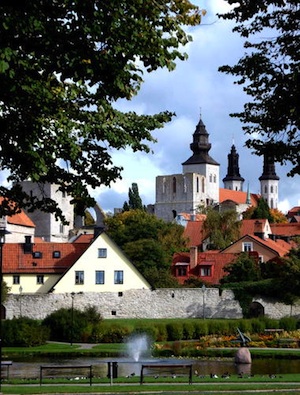Bio-fuelled district heating
A former Viking site on the island of Gotland, Visby was the main centre of the Hanseatic League in the Baltic from the 12th to the 14th century. Its 13th-century ramparts and more than 200 warehouses and wealthy merchants’ dwellings from the same period make it the best-preserved fortified commercial city in northern Europe.
ヴィスビューの建物の保全の要素として, 地域暖房ネットワークの構築は、いくつかを開始しました 30 数年前に. 今, all heat in Visby’s district heating system is produced using a mix of renewable energies.
Visby’s district heating project is not an isolated case on an island where the use of renewable is guaranteed. Gotland is a showcase for a number of interesting and innovative renewable energy initiatives. This is not really surprising. Gotland has Sweden’s highest sunshine figures, enjoys good access to biofuels and is one of the best European locations for wind power. These natural assets, the entrepreneurship of the islanders and the municipality’s focus on strategic environmental planning have led to the realisation of many ideas for increasing the sustainability of Gotland’s local energy supply.
ヴィスの地域暖房におけるバイオ燃料
The World Heritage City of Visby consists of many unique buildings and mediaeval ruins that are built from limestone. その最も古い建物のいくつかは、美しくゴット砂岩でポータルやフリーズを刻んでいます. 両方のこれらの石は、空気中の汚染物質に敏感であり、, 特に, 化石燃料の燃焼からの排出量.
In Visby as a whole, district heating accounts for over 80 percent of all heating supplied to commercial premises and dwellings. To the benefit of Visby’s residents and the town’s heritage, this heating contributes to a sustainable society.
Environmental benefits are evident, since fossil fuels have not been used in Visby’s district heating since 2006. 地域暖房はヴィスの町の中心部の狭い通りで燃料輸送する必要がなくなり. さらに, the use of biofuels reduces the emission of sulphur and nitrogen oxides. 化石燃料の使用と比較し, それはまた、大気への二酸化炭素の純増を低下させる.
から 1980, ヴィスの地域暖房からの硫黄排出量は下落している 95 パーセント. 個別暖房と比較して, 地域暖房は、ヴィスビューの住民と町の敏感な文化遺産のための空気がクリーンで健康的な葉.
ヴィスビー地域暖房ネットワークからその熱を取り:
- 樹皮, 小枝, 枝や他の (欠けた) 森林クリアランスと製材の残基.
- と海水系熱ポンプ 11 MW容量.
- ヴィスビー今閉じた埋立地からバイオガス.
- 廃水処理プラントからのバイオ.
- 化石油を交換してバイオオイル.
In addition to that, the municipality has set very high standards for energy efficiency and they have launched a new plan for the historic centre, where energy aspects are integrated with a general plan for building conservation.
Eco-Municipality of Gotland
Visby is the seat of Gotland Municipality, which took the view to become “an ecologically sustainable society within the course of a generation”. Many years ago, the Municipality of Gotland adopted a route which would lead away from fossil fuels and towards reduced climate impact. 今日, all electricity used in the municipality’s operations is certificated as Good Environmental Choice, which means that it is produced solely from renewable energy sources.
Gotland has implemented interesting reference projects in a wide range of experiences that include wind power, RES Initiatives Viewer, solar PV and sustainable architecture. The island has been a pioneer in promoting local ownership by wind co-operatives, where around 2000 households are involved.
現在のところ, one of the smartest electricity network in the world is currently under development on the island. This allows that by using modern technology, large quantities of renewable energy sources can be integrated in the grid.
Lessons learned and replicability
Visby’s bio-fuelled district heating case shows the advantages of a smart alliance between renewable energy and heritage conservation, and can be taken as a model for many historic centres at those latitudes. This project is part of the common objective of achieving energy self-sufficiency from renewables by 2025, taking into account that the realisation of a Sustainable Energy System requires action at all levels of society.
The experience of Visby, and of Gotland in general, becomes more relevant if we take into account the geographical position of the island, in the middle of the Baltic Sea, that makes it a natural meeting place for cooperation between regions in the Baltic Sea Region.


















